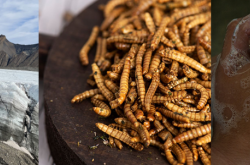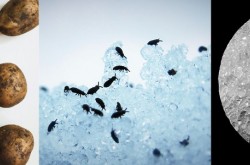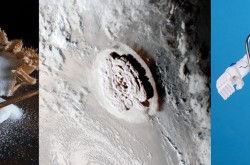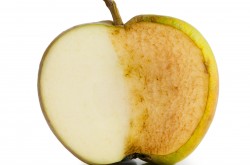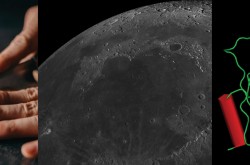3 Things you should know about marsquakes, the value of urine, and the chemistry of rhubarb

Meet Cassandra Marion, Renée-Claude Goulet, and Michelle Campbell Mekarski.
They are Ingenium’s science advisors, providing expert scientific advice on key subjects relating to the Canada Aviation and Space Museum, the Canada Agriculture and Food Museum, and the Canada Science and Technology Museum.
In this colourful monthly blog series, Ingenium’s science advisors offer up quirky nuggets related to their areas of expertise. For this April edition, Michelle Campbell Mekarski has invited Jacqueline Riddle — a Conservator at Ingenium — to fill in. Collectively, our experts explain how marsquakes can tell us about the interior of this planet, how urine's chemistry makes it a useful product, and how the chemicals found in rhubarb can affect our bodies.

Image captured by a camera onboard NASA’s Insight Lander looking at its tethered seismometer
Marsquakes offer 'insights’ into Mars’ interior
For the first time, direct observations of seismic waves have been detected moving through another planet’s interior. A pair of marsquakes detected in 2021 by NASA’s InSight lander show Mars’ core – the innermost layer – is smaller and denser than previously believed.
Insight was a NASA-led mission with the goal to investigate Mars’ interior, structure, and physical properties. Insight’s SEIS instrument pictured above, is a dome shaped seismometer that sits on the Martian surface and detects seismic waves, or vibrations. In a way, it listened to the planet’s heartbeat. It was so sensitive, it could register even tiny tremors from landslides and weather such as nearby dust devils on the surface.
Though the mission ended in December 2022, scientists continue to examine at the data. After four Earth years on the surface of Mars, it detected more than a thousand quakes but only two originating from the other side of the planet. This is important because the farther the quake, the deeper into the planet the seismic waves travel before being detected. Waves change as they pass through different material. To constrain the internal properties of Mars’ interior, scientists compared the travel times of waves moving through the core to those moving through the mantle (the middle layer). These detections enabled researchers to update the estimates of the planet’s interior, density, and composition. They concluded Mars has a liquid iron alloy core enriched in some lighter elements that is about 3,560 km in diameter.
One of the farside marsquakes, registered as a magnitude 4, was the result of a meteorite impact by a projectile up to 12 m wide, as evidenced by observations of a fresh impact crater 150 km in diameter by the Mars Reconnaissance Orbiter. The impact is significant as it marks a point of origin for the waves detected, but also excavated and exposed boulders of ice from beneath the surface.
With luck, future seismometers will tell us more about the interior of Mars and other bodies across the solar system, to better understand the nature of the material that formed the planet and its evolution.
Go Further
- The research article: First observations of core-transiting seismic phases on Mars
- Listen to the sounds recorded by Insight in December 2021 of a marsquake induced by a meteorite impact. (https://mars.nasa.gov/resources/27088/insight-records-the-sound-of-a-martian-impact/)
By Cassandra Marion

Rhubarb petioles – the part we eat – connect the leaf to the root system. It is best to pull the petiole from the ground rather than cutting it near the base.
Rhubarb chemistry: why we don’t eat its leaves and roots
One of the first plants to appear in the spring and the first to harvest, rhubarb is an early-summer classic in Canada! Though we mostly know it for its petioles – often misnamed as stems or sticks – there are two reasons you don’t want to eat rhubarb roots or leaves. On the other hand, with lots of sugar, the petioles can be delicious!
Rhubarb has a fascinating and complicated history that links back to the fact that it contains a surprising pharmacy! Its importance as a medicinal plant, and then a food crop, is what brought it to our gardens and backyards all the way from Asia. Before we were eating rhubarb petioles, rhubarb was prized for its root, which is used as medicine. The root contains a compound which our body converts into a new product called rheinanthrone (named after rhubarb's Latin name, Rheum). Rheinanthrone increases water in our stools and causes our intestines to contract and release...basically, it's an excellent laxative. Laxatives are a useful type of medicine to this day, but you wouldn't want to consume them without knowing. Luckily, there isn't enough of the rheinanthrone compounds in the petioles to give us the runs, so eat away but leave the root alone!
As for the leaves, most dog and cat owners know not to let their pets eat them, and it's for the same reason we don't eat them either. Rhubarb leaves contain oxalic acid, which is also found in high amounts in other plant foods, such as spinach, beets, tea, cocoa, and amaranth. In our body, oxalic acid binds with calcium, depleting the calcium that is needed for body functions. Further, this compound of oxalic acid and calcium can accumulate in our kidneys, causing dreaded kidney stones. Oxalic acid is toxic to humans in large doses, but a person would need to eat a few kilograms of rhubarb leaves for it to be lethal. Smaller amounts can still cause symptoms such as diarrhea and vomiting. Rhubarb leaf poisoning is more likely to happen in children and pets, since they need a smaller dose to be ill.
Much research is ongoing to learn about the health effects of rhubarb, and many more medicinal uses are being investigated, such as its possible anti-bacterial, anti-tumour, and anti-inflammatory activities. Who knows what the next big discovery will be in rhubarb-based medicine! But in the meantime, best to simply enjoy rhubarb for its delicious addition to our baked goods!
Go further:
- Learn more about 18th century “rhubarb mania” and why laxatives were so sought after: https://oldoperatingtheatre.com/gold-silver-and-rhubarb-britains-mystery-wonder-drug-that-became-its-favourite-pudding/
- Read about how plants like rhubarb growing in the wild serve as physical evidence of colonization in Northern Canada: https://canadiangeographic.ca/articles/the-surprising-links-between-people-and-plants-in-the-north/
By Renée-Claude Goulet

Reproduction of a 1700s urine flask, on display at the Canada Science and Technology Museum (Artifact no. 2017.0056)
How historic artisans used the chemistry of urine
We are accustomed to thinking of urine as a waste product, the number one to be flushed away with the stinky number two. On occasion, we might pee into a cup (or, in the 1700s, a flask like the one in the Canada Science and Technology Museum’s Medical Sensations exhibition) and give it to a doctor for an annual checkup or to diagnose an ailment. But beyond medical uses, twenty-first century humans typically do not consider urine to be useful.
Historic artisans, on the other hand, knew the value of this “liquid gold.” They saved, aged, and relied on urine to make a variety of products. Urine contains a mishmash of chemical compounds that made it useful to artists, coppersmiths, dyers, and tanners alike. In particular, the urea in urine converts to ammonia when aged, which is chemically handy for a variety of processes.
Aged urine can be used in the natural dyeing of textiles. The ammonia in the urine acts as a mordant, a substance that sets dyes into fabric. Mordants give a chemical “bear hug,” wrapping and binding dye molecules to the cloth. Without mordants, natural dyes would be washed away on the first wash. Historically, many households would save the urine from their chamber pots and use it while dyeing their own homemade clothing. Urine could also be used to clean and soften fabrics, and in fact was so useful in the textile industry that sixteenth-century Dutch textile workers were asked to bring their morning pee jar to work.
Urine was also used in the production of many historic pigments. Several recipes for making verdigris—a green copper-based pigment—mention the use of urine, including one by Pliny the Elder (1st century AD) that calls for “the urine of a young boy.” An additional recipe from the Medieval European text Mappae clavicula mentions the combination of copper, honey, oak wood, and human urine marinated for 14 days to produce a green pigment. But the use of urine is not relegated exclusively to green pigments. Historic production of Indian yellow pigment, used prolifically in Ragamala paintings in 15th to 18th century India, also relied on urine, in this case the urine of cows fed exclusively on mango leaves.

The West Block of Parliament copper roof during the recent rehabilitation project, showing a shiny new copper roof and an old green copper roof.
Closer to home - both temporally and geographically – coppersmiths in Ottawa also used the chemistry of urine to their advantage when building the Parliament Buildings. Recent visitors to Ottawa may have noticed the bright copper roofing on the newly renovated West Block of Parliament. Over the next 30 years, this bright copper will slowly turn brown, then green via a slow chemical reaction with oxygen, carbon dioxide, sulfur compounds, and moisture in the air. But the first coppersmiths building Parliament were apparently impatient, and would mop new copper roofs using readily available horse urine to speed up the formation of the green patina.
So many useful applications, and we just flush all that liquid gold away. That kind of waste could be enough to “piss” you off.
By Jacqueline Riddle
Enjoying the Ingenium Channel? Help us improve your experience with a short survey!


















